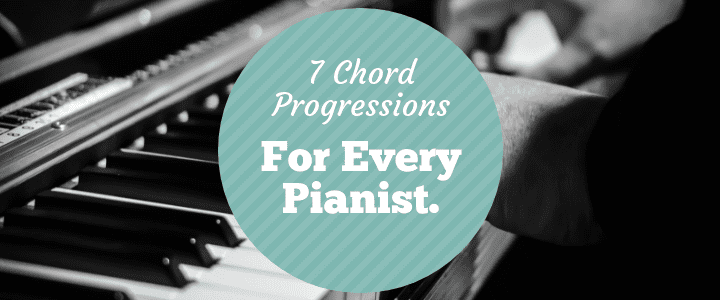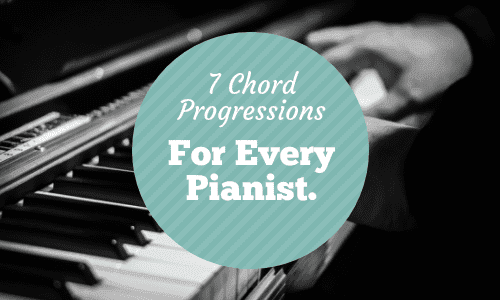
Piano chord progressions offer a view of music from a whole new perspective. Once you know some common variants, you’ll be able to create your own music, learn and sight-read written music more quickly, and have a greater understanding of music in general.
| 12 bar blues progression | I – I – I – I – IV – IV – I – I – V – V – I – I | C – C – C – C – F – F – C – C – G – G – C – C |
| “Cadential” chord progression | ii – V – I | Dmin – G – C |
| Songwriting & all-purpose | I – V – vi – IV | C – G – Amin – F |
| Classic 3-chord progression | I – IV – V | C – F – G |
| Canon (AKA Pachelbel) progression | I – V – vi – iii – IV – I – IV – V | C – G – Amin – Emin – F – C – F – G |
| 50s progression | I – vi – IV – V | C – Amin – F – G |
| Andalusian | I – ♭VII – ♭VI – V | Cmin – V♭ – A♭ – G |
In this post, we’ll walk you through some of the most common chord progressions piano players should know!
What Are the Most Common Piano Chord Progressions?
Piano chord progressions are sequences of chords that create harmony in music:
- The most common piano chord progression is the I-IV-V chord progression.
- Another common chord progression is the ii-V-I chord progression.
- The vi-IV-I-V chord progression is also frequently used in pop songs.
- Chord progressions can be altered or combined to create unique sounds and melodies.
Want to learn more about all the chord progressions piano players should know? This post will acquaint you with the basics, but you can also learn more by watching this video and asking your piano teacher for some tips:
https://www.youtube.com/watch?v=hCtgL5C-e2M
What is a Chord Progressions?
Piano chord progressions are simply a sequence of chords. (A chord is two or more notes played together). Chord progressions exist to develop the music in a harmonically meaningful way. Often, you can hear a “harmonic story” in each chord progression which includes a beginning, middle, and end.
Just how many piano chords are there? In order to notate and analyze chords, musicians use a system of Roman numerals. In each major key, there are seven unique chords, built off the notes of the scale. Each chord in the scale can be major, minor, diminished, or augmented.
Here are the notations for each chord in a major scale: I (major), ii (minor), iii (minor), IV (major), V (major), vi (minor), and vii° (diminished). As you can see, a capital Roman numeral indicates “major,” and a lowercase Roman numeral indicates “minor.”
The chart below lists minor piano chord progressions and a major piano chord.
| I | Major |
| ii | Minor |
| iii | Minor |
| IV | Major |
| V | Major |
| vi | Minor |
| vvi° | Diminished |
7 Piano Chord Progressions Everyone Should Know
The piano chord progressions on the following list can be used in any of the 12 major keys. For simplicity’s sake, our list of chord progressions below is shown both in Roman numerals and in the key of C Major, as an example. (The last progression on the list is an exception, which is in minor).
In each genre of music, there are specific chord progressions that are commonly used and well loved. Below, you’ll learn seven of the most common piano chord progressions from jazz, gospel, blues, and more! Looking for more help with piano chords? Check out this video tutorial:
1. The 12-Bar Blues Chord Progression
This chord progression is incredibly simple because it uses just three chords – I, IV, and V – but it has infinite possibilities for melodic improvisation. When played over 12 bars, this progression becomes a “12-bar blues.”
Note: A bar of music is a way of notating a set amount of time, or a certain number of beats, in the music. In the 12-bar blues, each bar would have four beats or counts, and each chord would last one bar. This makes 12 bars in total – one for each chord.
You can experiment with improvising on top of this chord progression using the blues scale. When this chord progression is used in a blues song, it’s repeated many times throughout the song. You’ll find the 12-bar blues in songs like Elvis Presley’s “Hound Dog,” BB King’s “The Thrill is Gone,” and Bill Haley’s “Rock Around the Clock.”
12-Bar Blues Example:
Thanks to 33 Evenstar for the use of this video.
Without further ado, check out the progression in C Major below. This chord progression, like all chord progressions, can be played in a variety of timings. Here, the chord progression (I-IV-I-V-I) is extended so it can last for 12 bars.
C – C – C – C – F – F – C – C – G – G – C – C
I – I – I – I – IV – IV – I – I – V – V – I – I
If you’d like, you can also practice this in other keys by transposing it. To do this, choose your key (say, G Major), and then use the sequence of Roman numerals above to create the same chord progression using the scale of G Major.
If you need more help or want to check your transposition, you can type in the chord names (i.e. C, G, F) here and they will be transposed to the key of your choice.
2. The “Cadential” Chord Progression
No piano chord progression list would be complete without this one, since it defies genre and is an essential ending progression. This is called a “cadential” chord progression in music theory, and it’s particularly common in classical, church, and gospel settings.
The ii-V-I chord progression is complete on its own, but it can also be made into the longer progression I-vi-ii-V-I. You can hear this progression in many jazz standards, including Miles Davis’ “Tune Up” and Eric Clapton’s “Tears in Heaven.”
Cadential Example
Thank you Epitaph for the use of this video.
Here’s what this progression would look like in C Major:
Dmin – G – C
ii – V – I
3. The Songwriting & All-Purpose Progression
This progression will likely sound familiar to you, as it’s extremely popular and has a dramatic sound – thanks to the minor vi chord. The progression lends itself very well to songwriting.
It can actually be altered by starting on any of the chords in the progression and then continuing in the same order (for example, V-vi-IV-I). Changing it in this way creates different tonal sentiments, from melancholy to drama.
Songs using this sequence are numerous, including the Beatles’ “Let It Be,” the Rolling Stones’ “Beast of Burden,” and Bruce Springsteen’s “I’m Goin’ Down.”
Songwriting & All-purpose Example
Here it is in all four alterations:
C – G – Amin – F / G – Amin – F – C / Amin – F – C – G / F – C – G – Amin
I – V – vi – IV / V – vi – IV – I / vi – IV – I – V / IV – I – V – vi
4. The Classic 3-chord Progression
This is one of the most versatile piano chord progressions, yet also one of the simplest! It’s been widely used as the basis for many songs, especially in modern pop. It’s also a good one to practice improvisation, since the progression itself doesn’t take a lot of concentration.
You’ll recognize it in Richie Valen’s “La Bamba,” Poison’s “Every Rose Has Its Thorn,” and Jerry Lee Lewis’ “Great Balls of Fire.”
Classic 3-Chord Example:
Here is the 3-chord progression in C Major, as an example:
C – F – G
I – IV – V
5. The Canon (AKA Pachelbel) Progression
This progression is named after Pachelbel’s Canon in D Major, an idyllic work that has become very well known. It is a more extended version of the previous I-IV-V progression. Like the 12-bar blues, it can be repeated many times within a single song.
The Canon progression appears in many genres, particularly pop. You’ll hear it in Aerosmith’s “Cryin’” and Blues Traveler’s “Hook.”
Canon (AKA Pachelbel) Example:
The progression looks like this in C Major:
C – G – Amin – Emin – F – C – F – G
I – V – vi – iii – IV – I – IV – V
6. The 50s Progression
This progression is a throwback to the 50s, although it’s still in use today. It has several different catchy names that speak to its versatility including the “Heart and Soul” chords, the “doo wop progression,” and the “ice cream changes.”
You can hear it featured in songs like Ben E. King’s hit “Stand By Me,” Green Day’s “Jesus of Suburbia,” and Bob Marley’s “Stir It Up.”
50s Chord Progression Example:
Thank you Soulful Sounds for the use of this video.
This chord progression makes the rounds in many genres, including pop, classical, reggae, and doo-wop.
C – Amin – F – G
I – vi – IV – V
7. Andalusian Cadence
Now that you know a number of basic piano chord progressions in major, here’s one that has a bit more flair thanks to its roots in Flamenco music. This progression is in minor, and it also uses chords that are lowered by a half step (♭ VII and ♭ VI).
You’ll hear the Andalusian cadence in Ace of Base’s “Cruel Summer,” Ray Charles’ “Hit the Road, Jack,” and Nina Simone’s “Don’t Let Me Be Misunderstood.”
Andalusian Cadence Example:
Thank you Andres Trevino for the use of this video.
The Andalusian cadence looks like this in C Minor:
Cmin – B♭– A ♭– G
i – ♭ VII – ♭ VI – V
A Few More Beautiful Chord Progressions Piano Players Should Know
As a piano player, nothing is more satisfying than playing a beautiful chord progression that resonates with your emotions and your listeners. Whether it’s a pop song, jazz solo, or classical piece – chord progressions are the foundation for great music.
Here are a few more to know.
Minor Piano Chord Progressions
If you want to create a somber, melancholic, or haunting mood in your piano playing, minor chords are the way to go. Some of the most beautiful minor chord progressions are: i – VI – III – VII (C min, Ab Major, E flat Major, B flat Major); i – V – vi – IV (C min, G Major, A min, F Major).
These chord progressions are widely used in pop, rock, and classical music. Experiment with different note combinations and rhythms to make them sound unique to your style.
Rock Chord Progressions for Piano
If you’re into rock music, you’ll know that power chords and distorted guitar sounds are staple sounds in the genre.
However, as a piano player, you can create some impressive rock sounds too! Try using the following chord progressions: I – IV – V (C Major, F Major, G Major); I – V – VI – IV (C Major, G Major, A minor, F Major).
These progressions are easy to play, and you can experiment with rhythm and dynamics to make them sound more interesting.
Jazz Piano Chord Progressions
Jazz is a genre that thrives on improvisation and creativity, which makes it a great playing field for beautiful chord progressions.
One of the most famous jazz chord progressions is the ii-V-I progression: ii7 – V7 – I (D minor 7, G7, C Major).
This progression is used in many jazz standards and can be used as a starting point for other progressions. Other chord progressions to try are: iii-vi-ii-V-I (E minor 7, A minor 7, D minor 7, G7, C Major); IV7 – IVdim – iii7 – vi7 (F7, F#dim, E minor 7, A7).
Sad Chord Progressions Piano Examples
Sometimes, you just want to play something that tugs at your heartstrings. Sad chord progressions can evoke emotions like empathy, loss, and longing.
A simple yet effective sad chord progression is Am – F – C – G. You can play this in a loop or add different variations to each chord to create an emotional soundscape.
Another sad chord progression is ii – V – I – VI (D minor, G Major, C Major, A minor). These progressions are also used in film scores and soundtracks to create a poignant atmosphere.
Happy Piano Chord Progressions
On the other hand, if you want to play something uplifting and joyful, happy chord progressions will do the trick.
Major chords are usually associated with happy moods, and some of the classic happy chord progressions are: I – IV – V (C Major, F Major, G Major); vi – IV – I – V (A minor, F Major, C Major, G Major). These progressions are easy to play and can be combined with catchy melodies to create a feel-good tune that will lift everyone’s spirits.
Tips for Learning Common Progressions: Piano Tips for Beginners
Learning how to play the piano can be an exciting and fulfilling experience, but it can also be overwhelming, especially for beginners. Here are some tips for learning common piano chord progressions.
Use a Piano Chord Progression Generator
One of the most effective ways to learn common progressions is by using a piano chord progression generator. This tool can be found online, and it’s easy to use. All you have to do is choose the key you want to play in, select a genre, and then generate a chord progression.
You can then download or print the progression and practice it on your piano. Using a progression generator not only saves time but also exposes you to common chord progressions used in different genres of music.
Try Chord Progression Chart Piano Options
Another method you can use to learn chord progressions is by using a chord progressions chart for piano. This chart shows you the different types of chords and the order in which they are played.
Armed with this knowledge, you can then practice the progressions on your piano. A chord progressions chart for piano can be found online, and you can print it out for reference when practicing.
Listen to Songs
One of the best ways to learn common progressions is by listening to songs. Pick a song that you like and listen to it closely. Pay attention to the chords used in the song and the order in which they are played. You can then try to practice the same chords on your piano. Listening to songs not only helps you identify common progressions, but it also helps you improve your piano playing skills.
Practice, Practice, Practice
The most important tip for learning common progressions is to practice consistently. As a beginner, it’s essential to practice every day, even if it’s just for a few minutes. The more you practice, the more you’ll become comfortable with playing different progressions. You can start with simple progressions and then work your way up to more complex ones.
Piano Chord Progressions Will Open New Doors to You As a Musician
Chord progressions are fundamental to playing the piano proficiently and understanding music on a deeper level. To learn more about chord progressions and the chord theory piano behind them, piano lessons are a great solution.
A piano teacher can help demystify music theory, and give you personalized exercises to train your ear and fingers. Try an online piano class, or take one-on-one piano lessons with a professional instructor near you to learn more.
 Post Author: Nadia B.
Post Author: Nadia B.Nadia B. teaches local and online piano lessons in New York, NY. She has been teaching since 2003, and has a degree in Music Performance from New York University. Learn more about Nadia here!
Nadia B.
